British_history_2 英语国家概况 英国历史相关
- 格式:ppt
- 大小:4.81 MB
- 文档页数:44
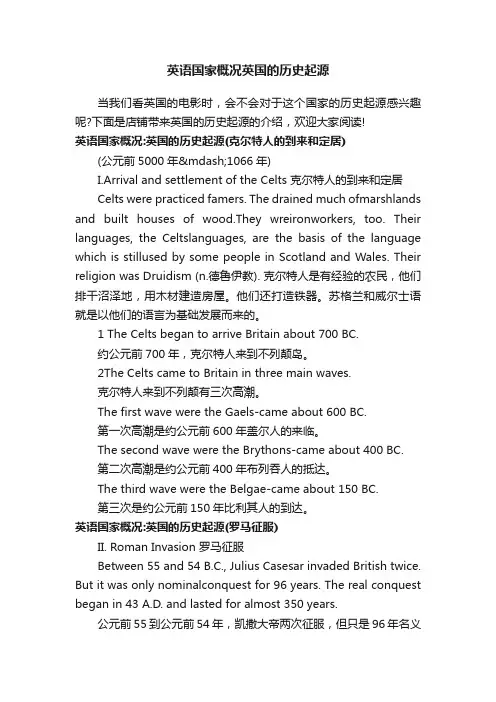
英语国家概况英国的历史起源当我们看英国的电影时,会不会对于这个国家的历史起源感兴趣呢?下面是店铺带来英国的历史起源的介绍,欢迎大家阅读!英语国家概况:英国的历史起源(克尔特人的到来和定居)(公元前5000年—1066年)I.Arrival and settlement of the Celts 克尔特人的到来和定居Celts were practiced famers. The drained much ofmarshlands and built houses of wood.They wreironworkers, too. Their languages, the Celtslanguages, are the basis of the language which is stillused by some people in Scotland and Wales. Their religion was Druidism (n.德鲁伊教). 克尔特人是有经验的农民,他们排干沼泽地,用木材建造房屋。
他们还打造铁器。
苏格兰和威尔士语就是以他们的语言为基础发展而来的。
1 The Celts began to arrive Britain about 700 BC.约公元前700年,克尔特人来到不列颠岛。
2The Celts came to Britain in three main waves.克尔特人来到不列颠有三次高潮。
The first wave were the Gaels-came about 600 BC.第一次高潮是约公元前600年盖尔人的来临。
The second wave were the Brythons-came about 400 BC.第二次高潮是约公元前400年布列吞人的抵达。
The third wave were the Belgae-came about 150 BC.第三次是约公元前150年比利其人的到达。
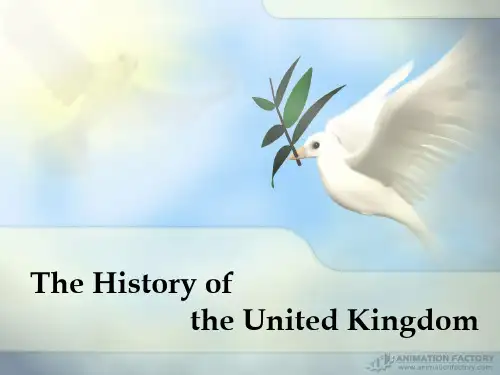
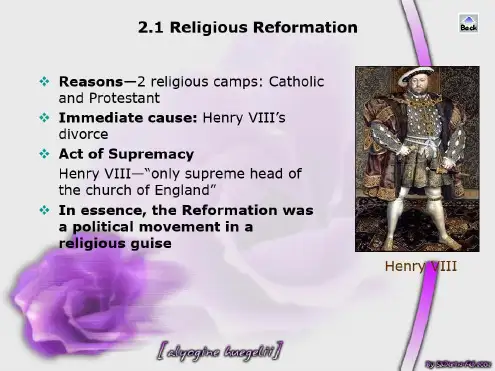
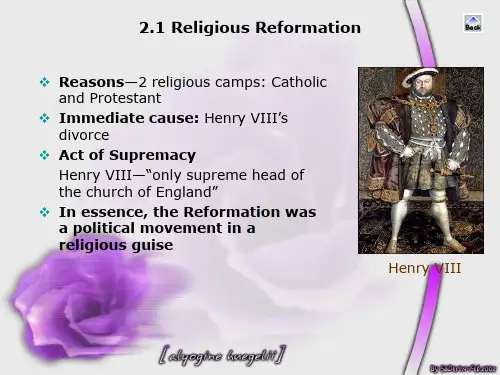
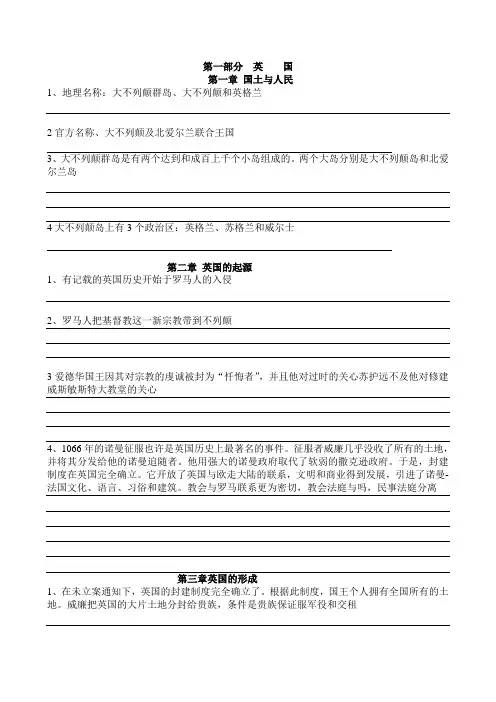
第一部分英国第一章国土与人民1、地理名称:大不列颠群岛、大不列颠和英格兰2官方名称、大不列颠及北爱尔兰联合王国3、大不列颠群岛是有两个达到和成百上千个小岛组成的。
两个大岛分别是大不列颠岛和北爱尔兰岛4大不列颠岛上有3个政治区:英格兰、苏格兰和威尔士第二章英国的起源1、有记载的英国历史开始于罗马人的入侵2、罗马人把基督教这一新宗教带到不列颠3爱德华国王因其对宗教的虔诚被封为“忏悔者”,并且他对过时的关心苏护远不及他对修建威斯敏斯特大教堂的关心4、1066年的诺曼征服也许是英国历史上最著名的事件。
征服者威廉几乎没收了所有的土地,并将其分发给他的诺曼追随者。
他用强大的诺曼政府取代了软弱的撒克逊政府。
于是,封建制度在英国完全确立。
它开放了英国与欧走大陆的联系,文明和商业得到发展,引进了诺曼-法国文化、语言、习俗和建筑。
教会与罗马联系更为密切,教会法庭与吗,民事法庭分离第三章英国的形成1、在未立案通知下,英国的封建制度完全确立了。
根据此制度,国王个人拥有全国所有的土地。
威廉把英国的大片土地分封给贵族,条件是贵族保证服军役和交租2、威廉用大议会取代了盎格鲁-撒克逊过往的顾问团——贤人会议。
大会以由他的土地承租人组成,一旦国王着急,他们就得为大议会服务3、《大宪章》是约翰国王于1215年在封建贵族的压力下签定的。
《大宪章》共有63条,其中最重要的内容是:没有大议会批准不得征税:只有依照国家有关法律才能逮捕、拘谨自由人及剥夺他们的财产:教会影响收起所有权利且具有选举自由;伦敦河其他城市应保留其古时的权利和特权;全国应统一度量衡4尽管《大宪章》长期以来被普遍认为是英国自由的基础,但它规定的只是国王与贵族之间的封建关系与法律关系,保证了教会的自由,限制了国王的权利,指望权与封建法律的约束下5、战争的起因既有领土因素也有经济因素。
领土起因尤其与英国国王拥有法国的阿基坦大片公爵领地有密切联系。
随着法国国王势力日增,他们日益觊觎这篇从他们领土内被分割出去的土地。
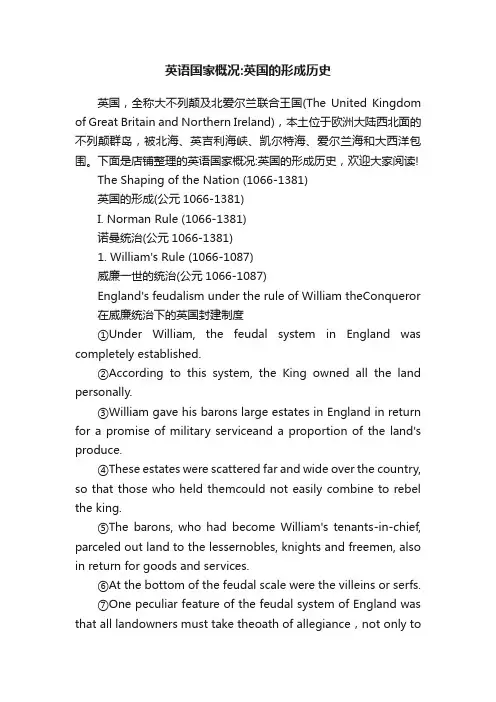
英语国家概况:英国的形成历史英国,全称大不列颠及北爱尔兰联合王国(The United Kingdom of Great Britain and Northern Ireland),本土位于欧洲大陆西北面的不列颠群岛,被北海、英吉利海峡、凯尔特海、爱尔兰海和大西洋包围。
下面是店铺整理的英语国家概况:英国的形成历史,欢迎大家阅读!The Shaping of the Nation (1066-1381)英国的形成(公元1066-1381)I. Norman Rule (1066-1381)诺曼统治(公元1066-1381)1. William's Rule (1066-1087)威廉一世的统治(公元1066-1087)England's feudalism under the rule of William theConqueror 在威廉统治下的英国封建制度①Under William, the feudal system in England was completely established.②According to this system, the King owned all the land personally.③William gave his barons large estates in England in return for a promise of military serviceand a proportion of the land's produce.④These estates were scattered f ar and wide over the country, so that those who held themcould not easily combine to rebel the king.⑤The barons, who had become William's tenants-in-chief, parceled out land to the lessernobles, knights and freemen, also in return for goods and services.⑥At the bottom of the feudal scale were the villeins or serfs.⑦One peculiar feature of the feudal system of England was that all landowners must take theoath of allegiance,not only totheir immediate lord, but also to the king.①在威廉统治下,英国的封建制度得到完全确立。
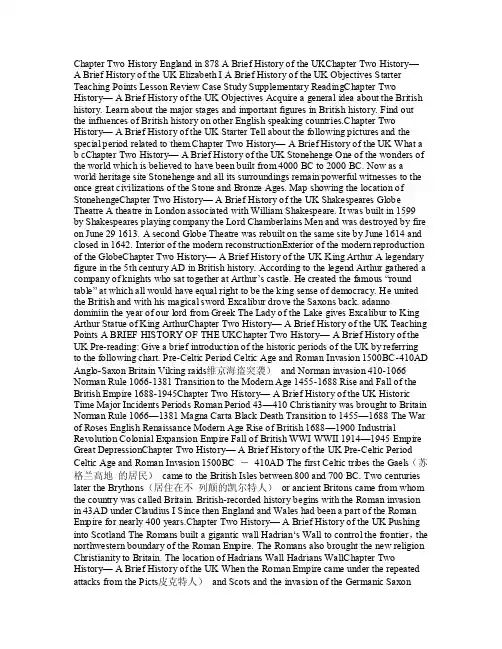
Chapter Two History England in 878 A Brief History of the UKChapter Two History—A Brief History of the UK Elizabeth I A Brief History of the UK Objectives Starter Teaching Points Lesson Review Case Study Supplementary ReadingChapter Two History— A Brief History of the UK Objectives Acquire a general idea about the British history. Learn about the major stages and important figures in British history. Find out the influences of British history on other English speaking countries.Chapter Two History— A Brief History of the UK Starter Tell about the following pictures and the special period related to them.Chapter Two History— A Brief History of the UK What a b cChapter Two History— A Brief History of the UK Stonehenge One of the wonders of the world which is believed to have been built from 4000 BC to 2000 BC. Now as a world heritage site Stonehenge and all its surroundings remain powerful witnesses to the once great civilizations of the Stone and Bronze Ages. Map showing the location of StonehengeChapter Two History— A Brief History of the UK Shakespeares Globe Theatre A theatre in London associated with William Shakespeare. It was built in 1599 by Shakespeares playing company the Lord Chamberlains Men and was destroyed by fire on June 29 1613. A second Globe Theatre was rebuilt on the same site by June 1614 and closed in 1642. Interior of the modern reconstructionExterior of the modern reproduction of the GlobeChapter Two History— A Brief History of the UK King Arthur A legendary figure in the 5th century AD in British history. According to the legend Arthur gathered a company of knights who sat together at Arthur‘s castle. He created the famous ―round table‖ at which all would have equal right to be the king sense of democracy. H e united the British and with his magical sword Excalibur drove the Saxons back. adanno dominiin the year of our lord from Greek The Lady of the Lake gives Excalibur to King Arthur Statue of King ArthurChapter Two History— A Brief History of the UK Teaching Points A BRIEF HISTORY OF THE UKChapter Two History— A Brief History of the UK Pre-reading: Give a brief introduction of the historic periods of the UK by referring to the following chart. Pre-Celtic Period Celtic Age and Roman Invasion 1500BC-410AD Anglo-Saxon Britain Viking raids维京海盗突袭)and Norman invasion 410-1066 Norman Rule 1066-1381 Transition to the Modern Age 1455-1688 Rise and Fall of the British Empire 1688-1945Chapter Two History— A Brief History of the UK Historic Time Major Incidents Periods Roman Period 43—410 Christianity was brought to Britain Norman Rule 1066—1381 Magna Carta Black Death Transition to 1455—1688 The War of Roses English Renaissance Modern Age Rise of British 1688—1900 Industrial Revolution Colonial Expansion Empire Fall of British WWI WWII 1914—1945 Empire Great DepressionChapter Two History— A Brief History of the UK Pre-Celtic Period Celtic Age and Roman Invasion 1500BC -410AD The first Celtic tribes the Gaels(苏格兰高地的居民)came to the British Isles between 800 and 700 BC. Two centuries later the Brythons(居住在不列颠的凯尔特人)or ancient Britons came from whom the country was called Britain. British-recorded history begins with the Roman invasion in 43AD under Claudius I Since then England and Wales had been a part of the Roman Empire for nearly 400 years.Chapter Two History— A Brief History of the UK Pushing into Scotland The Romans built a gigantic wall Hadrian‗s Wall to control the frontier,the northwestern boundary of the Roman Empire. The Romans also brought the new religion Christianity to Britain. The location of Hadrians Wall Hadrians WallChapter Two History— A Brief History of the UK When the Roman Empire came under the repeated attacks from the Picts皮克特人)and Scots and the invasion of the Germanic Saxontribes the Roman army pulled out of Britain in 410 AD leading to the swift breakdown of Roman civilization. It is said that in the 5th century AD King Arthur united Britain and drove the Saxons out of the country with his magical sword Excalibur. King ArthurChapter Two History— A Brief History of the UK Anglo-Saxon Britain Viking raids and Norman invasion 410 -1066 Invaders of three Teutonic(日耳曼条顿人)tribes came to Britain in the mid-5th century. –firstly the Jutes(fishing and farming from southern Denmark in the mid-5th century –the Saxonsusers of short sword from northern Germany from the end of 5th century to the beginning of the 6th century –the Anglesnorthern Germany who came in the second half of the 6th century and who were to give their name to the English people. English the language of the Angles replace the old celtic and the country became known as England meaning the land of UKChapter Two History— A Brief History of the the Angles Alfred the Great By 850AD the country was under sustained attacks from Norwegian Viking raids. The Saxon king Alfred the Great also known as ―Father of the British Navy‖ gradually pushed the Vikings northwards and eventually into the sea. By 955 Alfred‘s grandson Ethelred ruled over Eadred a united England and the government became centralized.Chapter Two History—A Brief History of the UK Viking invasions renewed till 1066 when King Harold marched north and won a victory over the Vikings. On October 1066 William of Normandy known as ―William the Conqueror‖ defeated Harold‘s army and crowned himself William I in London on Christmas Day 1066 becoming the first Norman king of William the Conqueror England.Chapter Two History— A Brief History of the UK This period can be characterised as a transition from a tribal to feudal society. TheAnglo-Saxons brought their own Teutonic religion to Britain. The names Tuesday Wednesday Thursday and Friday respectively derive from their gods. — Tiu—god of war — Woden—king of heaven — Thor—god of storms — Freya—goddess of peace Christianity almost disappeared until 597 when Pope Gregory I of Roman came to England and began to convert the heathen 异教徒)English to Christianity. Pope Gregory IChapter Two History— A Brief History of the UK Norman Rule 1066 -1381 Under William the Conqueror the feudal system was completely established. — He confiscated almost all the land and gave it to his Norman followers. — He replaced the weak Saxon rule with a strong Norman government. — Relations with the Continents were opened. — Norman French culture language manners Priory Church and architecture were introduced. — The church was kept completely under the control of the king. — The Norman culture flowered on the English soil. — Monasteries formed the new cultural centers. Monastic CommunityChapter Two History— A Brief History of the UK Economic administrative and legal reforms from Henry II the first king of the House of Plantagenet: —abolishing the annual land tax —strengthening the king‘s Court and extending its judicial work —reforming certain abuses in Church Henry II government by restricting the power of the archbishopChapter Two History— A Brief History of the UK。

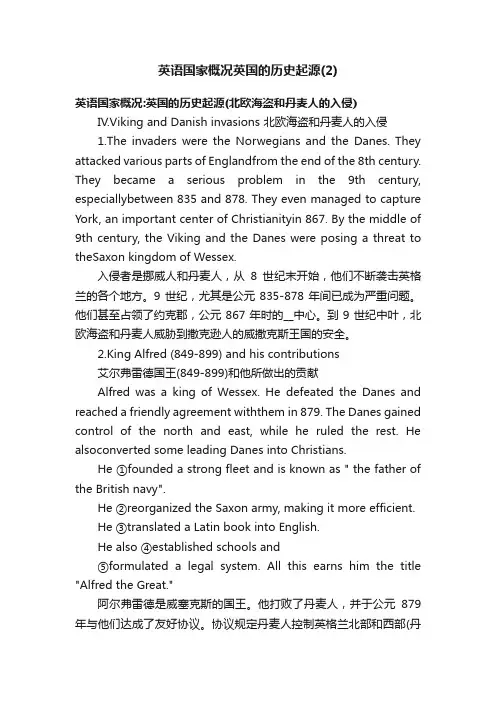
英语国家概况英国的历史起源(2)英语国家概况:英国的历史起源(北欧海盗和丹麦人的入侵) IV.Viking and Danish invasions 北欧海盗和丹麦人的入侵1.The invaders were the Norwegians and the Danes. They attacked various parts of Englandfrom the end of the 8th century. They became a serious problem in the 9th century, especiallybetween 835 and 878. They even managed to capture York, an important center of Christianityin 867. By the middle of 9th century, the Viking and the Danes were posing a threat to theSaxon kingdom of Wessex.入侵者是挪威人和丹麦人,从8世纪末开始,他们不断袭击英格兰的各个地方。
9世纪,尤其是公元835-878年间已成为严重问题。
他们甚至占领了约克郡,公元867年时的__中心。
到9世纪中叶,北欧海盗和丹麦人威胁到撒克逊人的威撒克斯王国的安全。
2.King Alfred (849-899) and his contributions艾尔弗雷德国王(849-899)和他所做出的贡献Alfred was a king of Wessex. He defeated the Danes and reached a friendly agreement withthem in 879. The Danes gained control of the north and east, while he ruled the rest. He alsoconverted some leading Danes into Christians.He ①founded a strong fleet and is known as " the father of the British navy".He ②reorganized the Saxon army, making it more efficient.He ③translated a Latin book into English.He also ④established schools and⑤formulated a legal system. All this earns him the title "Alfred the Great."阿尔弗雷德是威塞克斯的国王。


引言概述英国是一个拥有悠久历史和丰富文化的英语国家,位于欧洲大陆西北部,是世界上五个英语国家之一(其他四个分别是美国、加拿大、澳大利亚和新西兰)。
英国是一个由四个国家组成的联合王国,包括英格兰、苏格兰、威尔士和北爱尔兰。
本文将重点介绍英国的历史概况,从不同的时期、事件和人物来探讨英国历史的发展轨迹。
正文内容一、古代历史1.不列颠时期:介绍不列颠岛上原始民族的聚居,包括凯尔特人和罗马人的入侵等重要事件。
2.盎格鲁-撒克逊时期:讲述盎格鲁-撒克逊部落的入侵和建立英格兰王国的过程,以及统一英格兰的重要国王。
3.维京时期:探讨维京人的海上势力和对英国的影响,特别是他们在诺曼底登陆中的角色。
二、中世纪历史1.诺曼底征服:介绍威廉一世成为英格兰国王,建立诺曼底王朝的历史背景和影响。
2.骑士精神和十字军东征:探讨中世纪欧洲的骑士精神和十字军东征对英格兰的影响,以及英格兰维持外交平衡的策略。
3.玫瑰战争:讲述兰开斯特家族和约克家族之间的争斗,以及亨利七世的登基结束了这场战争。
三、近代历史1.英国帝国扩张:探讨英国帝国的形成和扩张过程,包括殖民地的建立、工业革命对英国的影响以及英国对全球贸易的控制。
2.工业革命和城市化:介绍英国在18世纪和19世纪的工业革命,以及城市化进程对社会结构和经济发展的影响。
3.英国政治制度的演变:探讨英国政治制度的演变,包括君主立宪制度的建立、议会的权力扩大以及普选权的实现。
四、现代历史1.两次世界大战:讲述英国在两次世界大战中的角色和贡献,特别是在二战中与纳粹德国的斗争。
2.工党和保守党执政:探讨英国工党和保守党在近代的执政经历和政策变化。
3.英国加入欧盟和脱欧:介绍英国加入欧盟的历史背景和对英国的影响,以及脱欧公投和英国脱欧的过程。
五、现代英国文化与社会1.英国皇室:介绍英国皇室的历史和现状,以及对英国文化和社会的影响。
2.英国文学和艺术:探讨英国文学和艺术的发展,包括莎士比亚、狄更斯等重要作家和艺术家的作品对全球文化的影响。
abriefhistoryofBritain英国历史简述(精选五篇)第一篇:a brief history of Britain 英国历史简述A Brief History of Britainby Pam BarrettWhen French and British construction workers met beneath the English Channel in 1990, Britain became linked to Continental Europe for the first time in 7,000 years.For it was then, when the last Ice Age ended, that melting ice flooded the low-lying lands, creating the English Channel and the North Sea and turning Britain into an island.This fact of being “set apart” was one of the two seemingly contradictory factors which would affect every aspect of the country’s subsequent history.The other was a genius for absorbing every invader and immigrant, creating a mongrel breed whose energies would establish an empire incorporating a quarter of the population of the planet.Early settlers: Stone Age people arrived, probably from the Iberian peninsula, in around 3000 BC.They lived by farming but left few traces.The most dramatic ancient monument is Stonehenge in Wiltshire, built during the next 1,000 years.How and why it was built was a mystery, but it must have had religious and political significance.The Beaker people, named after their pottery, were next to arrive.But a more importance wave of immigration, in 700 BC, was that of the Celts from eastern and central Europe.The ancestors of the Highland Scots, the Welsh and the Irish, they left behind a rich legacy of intricate and beautiful metalwork.The Romans: British recorded history began when Julius Caesar first crossed the English Channel in 55 BC.Roman rule continued for nearly 400 years, failing to subjugate only Scottish tribes, whose raiding parties were contained by Emperor Hadrian who built adefended wall right across the north of England.Eventually, threatened by barbarians at the gates of Rome, they abandoned Britain, leaving behind them a network of towns, mostly walled, a superb road system, and a new religion, Christianity.The next wave of invaders from central Europe – Angles, Saxons and Jutes – gradually pushed the native Celts west into Wales and north into Scotland.Anglo-Saxon dominance, too, lasted for four centuries, though it did not extend to Scotland, where a separate kingdom was forged by the Picts and the Scots.Although the Anglo-Saxons were a ferocious bunch, constantly squabbling, they laid the foundations of the English state, dividing the country into shires and devising an effective farming system.Their Teutonic religion, worshipping gods such as Woden and Thor, eclipsed Christianity until, at the end of the 6th century, the monk Augustine(once heard to remark “O Lord, make me chaste, but not yet”)converted the kings and the nobles.Monasteries sprang up, becoming places of learning.Treasures contained in the monasteries were a lure for the Vikings, whose ruthless raids from across the North Sea began in the 9th century.Initially they were defeated at sea by Alfred the Great, founder of the British Navy, but eventually they too were assimilated.Canute, the Danish leader, became king of Britain.The Norman Conquest: Links with Normandy, the part of France settled by the Vikings, were strong, and in 1066 William, Duke of Normandy, claimed the English throne.His triumph at the battle of Hastings decisively changed English history.As W.C.Sellar and R.J.Yeatman put it in their classic humorous history 1066 And All That: “The Norman Conquest was a Good Thing, as from this time onwards England stopped being conquered and thus was able to become top nation.”William parceled out the land to barons in return for their loyalty, and the barons parceled out land in turn to lesser nobles in return for goods and services.At the bottom were the peasants, whose feudal status resembled slavery – hence the potency of the Robin Hood legend, celebrating the Nottingham outlaw who stole from the rich to give to the poor.Although much of the Norman kings’ energies were devoted to protecting their borders, there was a great flowering of Norman culture, producing many erudite historians and scholars.In 1167 Oxford University was founded.Thanks to the influence of William Shakespeare’s history plays, much of the next period of English history is popularly remembered through his view of the shifting alliances of the Plantagenet and Tudor kings who ruled from 1154 to 1547.During this period of conflict and disease –the Black Death alone killed nearly half the population in 1348-49 –the royal succession was by no means assured.Power struggles propelled to the throne those who could command the greatest military backing from the majority of the rival barons, a process vividly illustrated by the Wars of Roses, the tussles between the House of Lancaster and York between 1455 and 1485.Frequent strife with France(including the intermittent Hundred Years’ War from 1337 to 1453)dominated international relationships.Internally, Wales was subjugated by 1288, though Scottish independence was recognized when Robert Bruce defeated English forces at the Battle of Bannockburn in 1314.Britain’s most famous king, Henry VIII, is remembered not only for his six wives(two of whom he had beheaded)but also for bringing about the Reformation, making England a Protestant rather than a Catholic countr y.His quarrel centred on the Pope’s refusal to annul his marriage to Catherine of Aragon, who couldnot oblige him with a male heir.Doctrinal differences aside, however, Henry capitalized on a growing distaste for the church’s excessive privilege and wealt h, and was thus able to get away with seizing enough monastic lands and property to finance his rule.Under Henry, Wales was formally united with England in 1536.The Age of Elizabeth: England entered its Golden Age under Elizabeth I, Henry’s daughter by Ann e Boleyn.The Elizabethan Age has a swashbuckling ring to it: the Virgin Queen and her dashing courtiers;the defeat of the Spanish Armada;Sir Walter Raleigh’s discovery of tobacco in Virginia;Sir Francis Drake’s circumnavigation of the world.Poetry, plays a nd pageantry flourished during her 45-year reign.When Elizabeth, the “Virgin Queen”, died without an heir, the throne passed to James VI of Scotland, who became James I of England, inaugurating the Stuart dynasty and effectively joining together the two kingdoms.The Stuart period was one of conflict between Crown and Parliament.James I, a staunch believer in the Divine Right of Kings, would have preferred no Parliament at all, and Charles I dissolved Parliament and initiated an 11-year period of absolute rule.The upshot was a civil war from 1622 to 1649;Charles lost and was beheaded.A period of republicanism followed, under the rule of Oliver Cromwell, but after his death the monarchy was restored and prospered under Charles II.His brother, who succeeded him as James II, was less circumspect and tried to restore absolute monarchy and the Catholic religion.The newly emerging political parties, growing in confidence, forced him to flee and invited his daughter Mary and her Dutch husband, Prince William of Orang e, to take the throne.This “Glorious Revolution”, although bloodless, was nonetheless a revolution and paved the way for Parliament’s permanent dominance overthe Crown.In 1707 an Act of Union united England and Scotland, although Scotland was allowed to retain its own Church and legislature.Many Scots felt that the union was bulldozed through by English politicians’ intent on improving their international trade prospects, and Scottish pressure to unravel the union is still a political issue.Political pragmatism triumphed again in 1714 when, a reliable Protestant monarch being needed in a hurry, a search through the family tree came up with George I of Hanover in Germany.Although he spoke no English and had little interest in his subjects, he founded a dynasty which was to span 115 years and encompass an expanding empire and an industrial revolution.The age of empire: Despite the loss of its American colonies in 1783, Britain’s trade-driven adventurism was undiminished, giving it control of West Africa and India, Newfoundland and Nova Scotia, some Caribbean island, and Australia and New Zealand.At home, farmers embraced more efficient and profitable methods, which led to the eviction of many peasant farmers who either emigrated to the New World, carrying with them a resentment that would bequeathed to future generations, or left the land to find work in the towns, which rapidly became overcrowded.This combination of landowners with surplus capital to invest and laborers in search of a living was one reason why British became the first country to industrialize.Political stability helped too, as did the security of being an island, natural resources, good trade arrangements and a native genius for inventing things.The Scottish inventor James Watt modified and improved the steam engine in the 1770s, opening the way for the efficient powering of trains, ships and factory machinery.The invention of the Spinning Jenny and the power loom created mass production in textiles.The smelting ofiron with coke, instead of charcoal, hugely increased the production of iron.A massive building program of railways, roads and canals created a new class of industrialist, whose fortunes rivaled those of the aristocracy.But it also created abominable working conditions in mines and factories, conditions which led to the slow and painful development of trade unionism.Political reforms, seized elsewhere in Europe by revolution, came gradually in Britain.Parliamentary seats were distributed more fairly among the growing new towns, but voting was still based on property ownership and universal suffrage didn’t come until 1918(and even then was scarcely universal since it excluded women under 30).The problem that dominated parliamentary debate during this period was the intractable Irish Question.The resentment over centuries of British rule in Ireland bubbled to the surface after the potato famines of the mid-1840s, when about 20 percent of Ireland’s population died of starvation and more than a million people emigrated to escape a similar fate.Demands for Irish independence grew but they were demands which many English politicians, conscious of the security problems of having an independent and possibly none-too-friendly neighbor to their west, were reluctant to grant.As with today’s IRA campai gn, the debate had a backdrop of violence.T oday, however, the Victorian Age is remembered as a time of exuberant self-confidence, symbolized by the building in London of the Crystal Palace to showcase Britain’s industrial and technical achievements in the Great Exhibition of 1851.But many of London’s inhabitants might well have wondered when they would benefit from all these accomplishments.For them, the squalor and crime which Charles Dickens portrayed so evocatively in his novels were all too real.Working-class lifeimproved considerably during the last quarter of the 19th century.Many homes had gas lighting and streets were cleaned by the new municipal councils.A new police force contained crime.The music hall provided inexpensive entertainment in towns.Bicycles became a common method of transport, and a trip by train to seaside resorts was for many a highlight of summer.In London, trains in the world’s first underground railway began puffing their way through smoke-filled tunnels between Paddington and Farrington in 1863.Art and drama flourished.By the time of Queen Victoria’s Diamond Jubilee in 1897, the country was feeling quite pleased with itself.Britannia ruled the waves, and anything seemed possible.The 20th century: But all good things come to an end.The Boer War of 1900 ended in victory for the British in South Africa but damaged its international reputation.France, Germany and America were becoming powerful competitors for world markets.The newly united German state was flexing its military muscles.The Edwardian era of the early 20th century, seemingly an idyllic time, was built on shifting sands.Dragged into World War I by a complex web of international alliances, Britain faced unimaginable carnage in which more than a million of its young men died.Social unrest at the end of the war, though less devastating than in the defeated Germany, gave more power to women(who had shouldered a heavy burden while the men were at war)and led to a General Strike by dissatisfied workers in 1926.The Irish Question was partly answered with the creation of an independent Irish free State, but six Protestant-dominated counties in the north stayed under UK rule – a time bomb which exploded in 1969.The shock waves from the 1929 New York Stock Market crash plunged Britain into depression, throwing millionsout of work, especially in the industrial areas of northern England, south Wales and Clydeside in Scotland.The monarchy was rocked by crisis in 1936 when Edward VIII, who had just become king, decided to marry the twice-divorced Mrs Wallis Simpson.His family, the church and the government opposed the match, forcing him to abdicate.His brother, a reluctant George VI, restored the monarchy’s popularity, not least through the support which he and his wife Elizabeth(later the Queen Mother)gave to their subjects during the German air raids of World War II.Although Britain’s island status saved it from invasion, this war involved civilians in an unprecedented way.Cities like Coventry were devastated by bombing and the Blitz radically changed the face of London for the first time since the Great Fire of 1666.Many children were sent to live in the countryside.Most social inequalities were set aside during the war and, when peace returned in 1945, voters turned to the Labour party in hope that it could develop an even greater egalitarianism.It laid the basis of a welfare state, providing free medical care for everyone as well as financial help for the old, the sick and the unemployed.But the war had left Britain broke.While Germany and Japan rebuilt their industries almost from scratch, helped by international aid, Britain was left to patch together a severely damaged economy.It could no longer sustain an empire, and gradually its colonies became independent.Many former subjects, especially from the Caribbean and the Indian sub-continent, settled in Britain, raising fears of racial conflict that, despite some serious tensions, were never(quite)fulfilled.As the austere 1950s gave way to the ’60s, things started to look up.New universities were built, a motorway network launched, and a reinvigorated culture promoted by a group of writersdubbed “the angry young men”.Much of the explosion of new talent came from the north of England: actors like Albert Finney, playwrights like Alan Sillitoe, and pop groups galore, led by the Beatles.The swinging Sixties, powered by a newly affluent youth, had arrived.Britain’s heavy industry might be in trouble, but in fashion and pop music it led the world.The good times died in the 1970s as inflation and unemployment soared and labour unrest led to endless strikes.Joining the European Community in 1973 seemed to produce few obvious economic benefits and revenues from North Sea oil were quickly spent rather than invested.Margaret Thatcher came to power in 1979 promising tough new policies.Her popularity quickly faded, but was revived in 1982 by the Falklands War when an invading Argentinean force was beaten off the South Atlantic islands, remnants of the old empire.Although she went on to win two further elections convincingly, by 1990 her popularity, always firmer abroad than at home, was so shaky that her party, fearing that she would not win them the next election, replaced her with a less combative leader, John Major.He duly won the 1992 election, but a reinvigorated Labour Party under T ony Blair won in 1997.The overall problems did not change, though.The economy remained weak, distrust of the European Community did not abate, nationalism simmered in Wales and Scotland, the conflict in Northern Ireland dra gged on, and the Royal Family’s private life continued to obsess the tabloid press.It was business as usual, in fact – which, in a country obsessed by continuity, was immensely reassuring.第二篇:材料学的历史简述姓名:何莞晨学号:2014012075材料学的历史简述1.按材料划分的时代生活离不开材料,人类的一切生产活动所需的工具都建立在合适的材料的基础上。
第二章英国的起源Ⅰ.早期的居民(公元前5000年--公元前55年)不列颠原先是欧洲大陆的一部分。
7000年前的冰川时代结束时,融冰淹没了低地,形成了英吉利海峡和北海,把不列颠变成了岛屿。
1.伊比利亚人人们所知的英国最早居民是伊比利亚人。
约在公元前3000年的新石器时代,这些身矮、肤黑、头长的人们来到英国,很可能来自伊比利亚半岛,即现在的西班牙。
他们是些饲养动物、种植庄稼的农民。
在威尔特郡和多塞特郡白精干垩地带发现的狭长古墓多数是他们的公共墓冢。
更为引人注目的是那些圆形石结构,其中最重要的是在威尔特郡发现的巨石阵。
巨石阵建于公元前2000年前,准确的修建原因无从了解,但肯定具有宗教和政治意义。
尽管流行神话总把巫师们与巨石阵联系起来,但巫师却是后来才到的凯(克)尔特人的祭司。
2.宽口陶器人约公元前2000年,从现在的荷兰和莱茵兰地区来了宽口陶器人。
这一种族得名于他们所用的特殊铃形宽口饮酒容器,这种陶器是陪葬品,分别埋在单个墓穴里,墓的主人呈蹲伏姿势。
他们还带来了制陶工艺、制造青铜工具的技术及单个安葬的习俗。
他们形成了自己的农耕社会并在山上建堡垒。
这些堡垒成了小型的城堡。
多塞特郡的梅登城堡是最好的实例之一。
3.克(凯)尔特人克(凯)尔特人比先前抵达的种族更高,是漂亮,他们于公元前700年迁入并于此后不断迁居到此岛,直至罗马人入侵。
最初他们可能来自东欧及中欧,即现在的法国、比利时和德国南部。
他们的入侵有三次高潮。
第一次高潮是约公元前600年盖尔人的来临。
第二次高潮是约公元前400年始布立吞(不列颠)人的抵达。
然后是约公元前150年贝尔盖人的到达。
克(凯)尔特人并未杀绝伊比利亚人,而是把其中一些赶到北部和西部,把其余的人用作奴隶。
最后,两个种族在这个国家的不同地区有了程度不同的混合。
贝尔盖人是克(凯)尔特部落中最勤奋、最精力充沛的。
最强大的酋长之一是卡西弗洛诺斯--卡诺比利诺斯的叔叔,即莎士比亚剧本中的辛白林。